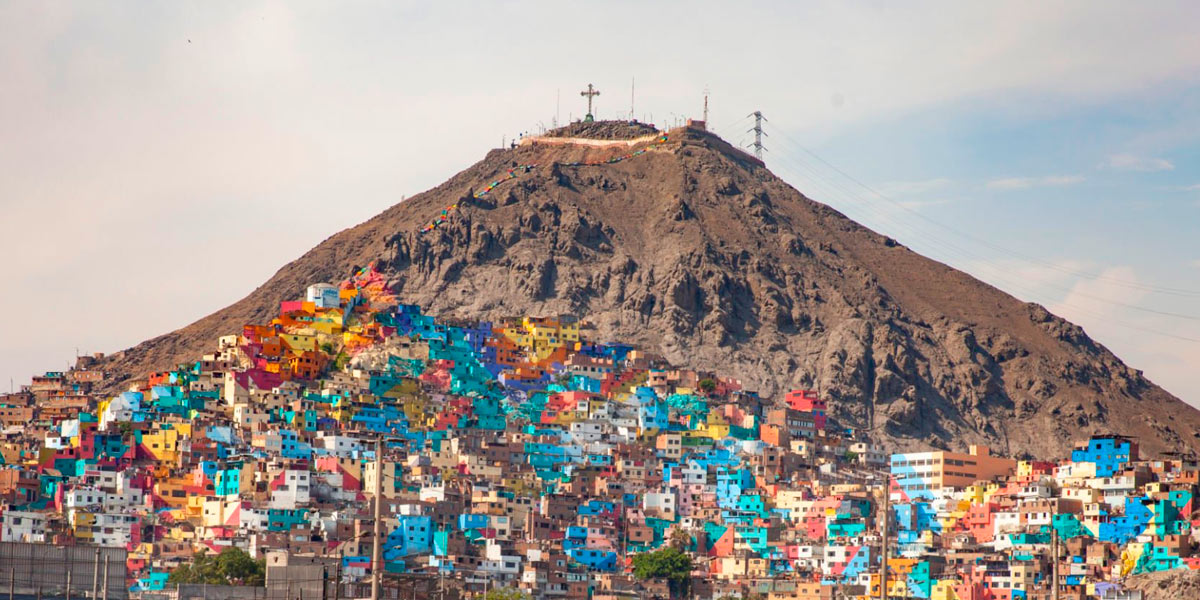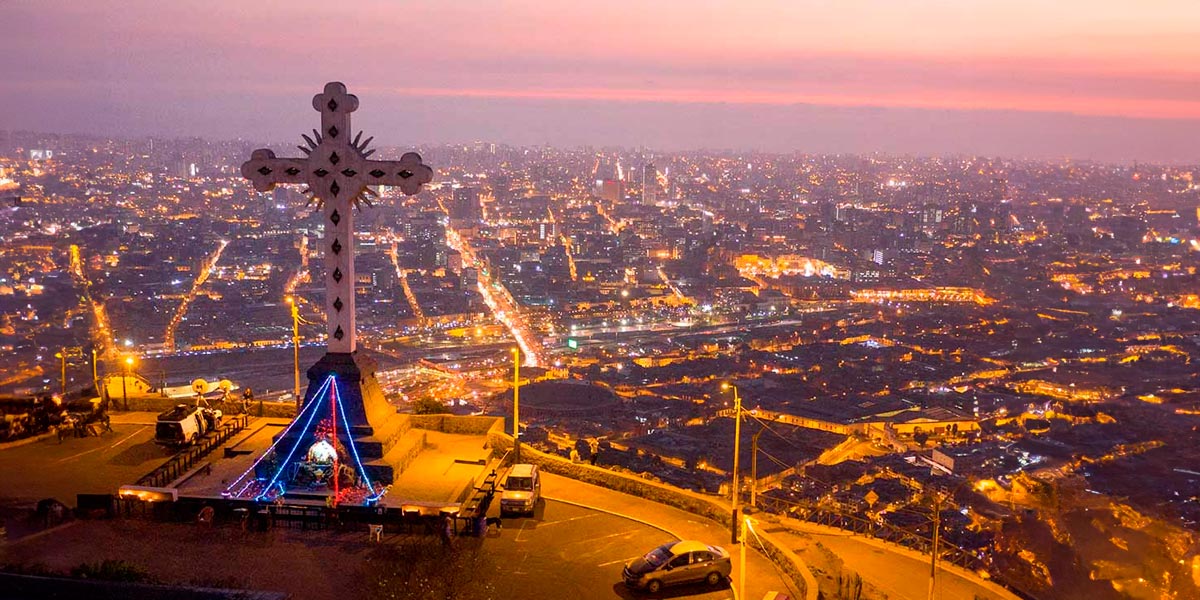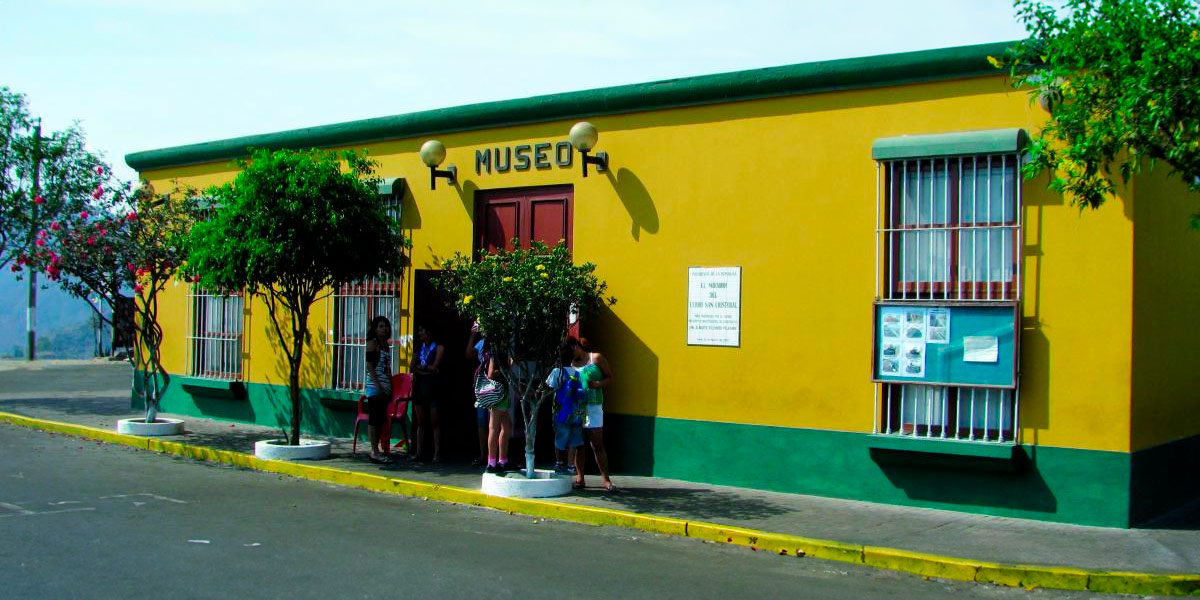San Cristobal Hill is one of the symbols of the city of Lima. It is the closest and highest hill in the city. Its importance dates back to the time of the Incas. Its current name was named by Francisco Pizarro in 1535. Today it offers one of the best panoramic views of the city. The route there can be booked in the Plaza de Armas. There are tours and rides on the popular 'mirabuses'. Learn more about this tourist attraction, one of the most symbolic of Lima.
From its summit, Lima opens to the skies and the sea. The San Cristóbal hill, in the Rimac district, has been the silent watchman of the Peruvian capital over the millennia in which man has lived in this place. Witness to the growth of the city, it is a Catholic pilgrimage site and an important tourist attraction.
It is an elevation that rises 300 meters above the level of the city. The formation belongs, orographically, to the isolated hills of the Andes mountain range.
A narrow and dizzying road takes the tourist to the top of the hill. The cross that crowns the elevation dates from the early years of the 20th century, when it replaced an old symbol that corroded over the years. The current one is built of reinforced concrete and measures 20 meters, in addition to being equipped with lighting.
At the top of the hill there is a site museum, which exhibits photographs and objects from Lima in its different periods. There is also the cross, toilets and you get magnificent views of the city. If it is clear you can see as far as Callao and the islands of San Lorenzo and Frontón.
The highest hill in Lima
San Cristóbal Hill is part of the Andean foothills located in the heart of the city of Lima. It is the highest hill in this area of the city, located at a height of 400 meters above sea level. From there you have an incredible view of the entire place, you can even see the famous islands in the port of Callao.
Currently it is one of the most representative tourist attractions in Lima. At the top, a 'monumental cross' was built in 1928 with 48 embedded luminaries that guard the entire city of Lima. At that time the road that leads to the top of the hill was also built.
The cross is frequently visited by people during Holy Week and the first Sunday in May (when the so-called 'Feast of the Crosses' is celebrated). Likewise, there is a site museum that exhibits photographs of Lima at the beginning of the 20th century.
San Cristóbal Hill is one of the main tourist attractions in the center of Lima, where the Plaza de Armas and the Cathedral also stand out.
There are currently plans to build a cable car to attract more tourists. Most visitors access the hill through a 'mirabus' trip or on a tour organized by a tourism agency.
Where is it located?
San Cristóbal Hill is located in the heart of Lima. It can be clearly seen from the Plaza de Armas, from where you must travel 10 kilometers by road. It is located on the border of the Rímac and San Juan de Lurigancho districts. Its altitude is only 400 meters above sea level.
What to do on Cerro San Cristóbal?
Cerro San Cristóbal, located in the traditional district of Rímac, is one of the best places to enjoy a panoramic view of Lima. If you plan to visit it, here are the main activities you can do:
- Climb to the main viewpoint
Reach the top of the hill and contemplate one of the most impressive views of the Peruvian capital. From there you can appreciate the magnitude of Lima, its neighborhoods, the Rímac River and, on clear days, even the Pacific Ocean. - Visit the Site Museum
At the top you will find a small museum where you can learn about the history of the hill and its cultural and religious importance throughout the centuries. It is an ideal stop to understand the spiritual meaning of the place for the people of Lima. - Observe the main points of the city
From the viewpoint you can identify emblematic places such as the Acho Bullring, the Rímac River, the Ricardo Palma Bridge, the Tacna Avenue Bridge, and the Wall Park. The towers of historical temples such as the Cathedral of Lima, San Francisco, and Santa Rosa are also distinguishable. - Enjoy the view and photography
Take advantage of the panoramic view to capture unique images of the city. Sunset is one of the best moments to take photographs, with the golden tones of the Lima sky as a background. - Learn about the foundational history of Lima
From the top you can see the so-called "Lima grid" ("reja de Lima"), the area where Francisco Pizarro traced the first foundations of the city over ancient pre-Hispanic settlements. An ideal point to reflect on the historical origin of the capital.
How to get to San Cristobal Hill?
To visit it you have to take precautions. Take a tour in the Plaza de Armas or a taxi to the top of the hill. It is not recommended to climb on your own, because the hill is surrounded by the popular areas of Lima where a solo tourist could leave with a bad memory.
- Wearing long sleeves and a hat is an essential precaution. At the top of the hill there is very little shade and you must protect yourself from the sun, even if it is cloudy.
- You can carry a water bottle to stay hydrated.
- Stay within the limits of the viewpoint, do not descend beyond the marked limits and obey all the guides' recommendations.
- If you go during Holy Week, you can walk up with the pilgrimage that takes place every year, with the stations of the Via Crucis, to the Holy Cross.
- Please do not throw garbage outside the specially designated containers.
History of San Cristóbal Hill
The history of San Cristobal Hill dates back to pre-Inca times. For the families or ayllus that inhabited the Rimac valley, this hill was sacred. This belief was also taken up by the Incas during their expansion along the Peruvian coast at the end of the 15th century.
During the Spanish conquest in the 16th century, a wooden cross was placed on top of the hill as a symbol of imposition of the new Western religion. In 1536 the Incas besieged Lima from this hill, destroying the cross. From Cusco the rebel Manco Inca ordered the attack that caused numerous deaths on both sides.
Finally, with the arrival of the Huayla tribes, the balance tipped in favor of the Spanish who bathed the waters of the Rímac River in blood. Battles continued in Pachacamac and Rumichaca. However, Francisco Pizarro had already ordered the reconstruction of the wooden cross and the name of the hill as San Cristóbal, since that day the arduous conflict was won.
With the establishment of the viceroyalty of Peru, the Spanish supplanted aboriginal beliefs with new Christian religious practices. This is how they established the practice of the Via Crucis there. At the beginning of the 20th century, the project to build a monorail that would easily lead to the top of the hill failed.
In those first days, a paved road was built, as well as a huge metal cross inaugurated in 1928. Likewise, in 1929, the parish priest Francisco Aramburú established the pilgrimage of the cross on the first Sunday of May.
At the end of the 20th century, the area leading to the hill, which was occupied by crime, was recovered. This is how the idea of creating a historic tourist area of Lima came to fruition. Currently there are plans to build a cable car that will increase the number of visitors.
The monumental cross of Saint Christopher
The monumental cross is a work designed at the beginning of the 20th century by the Franciscan priest Francisco Aramburú. The idea was to build a huge cross that guards the city and can be seen from the entire city, even at night.
The work was inaugurated in 1928 during the government of President Augusto B. Leguía. The architect was the Peruvian Oscar Zagazeta Valderrama. The cross is 20 meters high and has 48 embedded luminaries that illuminate the Lima night.
From the cross you have a privileged view of the city. It is made of concrete so strong that it has successfully withstood the strong earthquakes of 1940, 1966, 1974 and more.
The cross has become a symbol of the city. Thousands of faithful come there on pilgrimage during Holy Week and the Feast of the Crosses (first Sunday in May).
The site museum
On the esplanade of San Cristóbal Hill, and a few steps from the monumental cross, there is a site museum that offers a photographic gallery about the customs and culture of the city of Lima.
The museum is open every day from 8 in the morning until 3:30 in the afternoon. The entrance ticket costs only 1 sol per adult. Children enter free.
How much does the visit cost?
San Cristóbal Hill is in a free area of the city so entry is free.
The 'mirabus' tour from the Plaza de Armas in Lima costs 20 Peruvian soles. In addition to San Cristóbal Hill, it includes a walk through the main historic streets of the city. The tour lasts approximately 2 hours 30 minutes.
More important information
Before the founding of Lima in 1535, the area that includes the historic center of Lima belonged to the chief Taulichusco. Even the space occupied by the Cathedral was a sacred temple called 'Puma Inti', located next to the palace of the Inca ruler 'Sinchi Puma'.
A good time to visit San Cristóbal Hill is during Holy Week, when the Via Crucis is staged with dozens of actors. During this staging, the actor representing Jesus ascends to the top of the hill carrying a heavy cross with him. That day hundreds of faithful and curious people gather along the slopes of the hill.
Best Tours in Peru
Many are the routes that take you to Machu Picchu, but none is like the Inca Trail Tours, the most famous pedestrian path in the Americas. After flying from the capital of Perú, Lima, you will arrive in Cusco to walk for four days along a path through forests and dense fog, millenary stone steps and discovering the ruins of ancient fortifications and Inca cities, and all the time enjoying majestic views.
- Peru Adventure Holidays
- Enigmatic Peru
- Peru Full of Adventures
- Peru Luxury Travel
- Peruvian Highlands
- Discover Peru
Inca Trail, Machu Picchu and more
- Salcantay Trek Peru to Machu Picchu 5 days
- Palcoyo Mountain Tour
- Cusco to Manu Tour
- Humantay Lake Day Trip
- Huchuy Qosqo Day Hike
- Llactapata Inca Trail to Machu Picchu
- Apurimac River Rafting
- Vilcabamba Trek to Machu Picchu
- Inti Raymi and Machu Picchu Tour
If you want to visit Machu Picchu, we recommend you to book your Machu Picchu Ticket in advance, so you will enjoy your Vacation in Machu Picchu without any problem.










